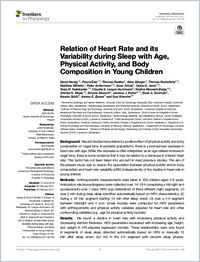Relation of Heart Rate and its Variability during Sleep with Age, Physical Activity, and Body Composition in Young Children
- Herzig, David Preventive Cardiology and Sports Medicine, University Clinic for Cardiology, Inselspital, Bern University Hospital, University of Bern, Bern, Switzerland
- Eser, Prisca Preventive Cardiology and Sports Medicine, University Clinic for Cardiology, Inselspital, Bern University Hospital, University of Bern, Bern, Switzerland
- Radtke, Thomas Universität Zürich
- Wenger, Alina Universität Zürich
- Rusterholz, Thomas Universität Zürich
- Wilhelm, Matthias Preventive Cardiology and Sports Medicine, University Clinic for Cardiology, Inselspital, Bern University Hospital, University of Bern, Bern, Switzerland
- Achermann, Peter Universität Zürich
- Arhab, Amar Centre Hospitalier Universitaire Vaudois (CHUV), Lausanne, Switzerland
- Jenni, Oskar G. Universität Zürich
- Kakebeeke, Tanja H. Universität Zürich
- Leeger-Aschmann, Claudia S. Universität Zürich
- Messerli-Bürgy, Nadine Universität Fribourg, Schweiz
- Meyer, Andrea H. Universität Basel
- Munsch, Simone Universität Fribourg, Schweiz
- Puder, Jardena J. Centre Hospitalier Universitaire Vaudois (CHUV), Lausanne, Switzerland
- Schmutz, Einat A. Universität Zürich
- Stülb, Kerstin Universität Fribourg, Schweiz
- Zysset, Annina E. University Children's Hospital Zürich
- Kriemler, Susi Universität Zürich
-
24.02.2017
Published in:
- Frontiers in Physiology. - 2017, vol. 8, no. 109, p. 1-12
Heart rate variability
Children
Cardiovascular health
Cardiac autonomic nervous system
Growth
SPLASHY
English
Background: Recent studies have claimed a positive effect of physical activity and body composition on vagal tone. In pediatric populations, there is a pronounced decrease in heart rate with age. While this decrease is often interpreted as an age-related increase in vagal tone, there is some evidence that it may be related to a decrease in intrinsic heart rate. This factor has not been taken into account in most previous studies. The aim of the present study was to assess the association between physical activity and/or body composition and heart rate variability (HRV) independently of the decline in heart rate in young children. Methods: Anthropometric measurements were taken in 309 children aged 2–6 years. Ambulatory electrocardiograms were collected over 14–18 h comprising a full night and accelerometry over 7 days. HRV was determined of three different night segments: (1) over 5 min during deep sleep identified automatically based on HRV characteristics; (2) during a 20 min segment starting 15 min after sleep onset; (3) over a 4-h segment between midnight and 4 a.m. Linear models were computed for HRV parameters with anthropometric and physical activity variables adjusted for heart rate and other confounding variables (e.g., age for physical activity models). Results: We found a decline in heart rate with increasing physical activity and decreasing skinfold thickness. HRV parameters decreased with increasing age, height, and weight in HR-adjusted regression models. These relationships were only found in segments of deep sleep detected automatically based on HRV or manually 15 min after sleep onset, but not in the 4-h segment with random sleep phases. Conclusions: Contrary to most previous studies, we found no increase of standard HRV parameters with age, however, when adjusted for heart rate, there was a significant decrease of HRV parameters with increasing age. Without knowing intrinsic heart rate correct interpretation of HRV in growing children is impossible.
- Faculty
- Faculté des lettres et des sciences humaines
- Department
- Département de Psychologie
- Language
-
- English
- Classification
- Medicine
- License
- License undefined
- Identifiers
-
- RERO DOC 323529
- DOI 10.3389/fphys.2017.00109
- Persistent URL
- https://folia.unifr.ch/unifr/documents/307527
Statistics
Document views: 148
File downloads:
- _frontiers.physio_relationofheartrateanditsvariabilityduringsleepwithagephysicalactivityandbodycompositioninyoungchildren.pdf: 213
